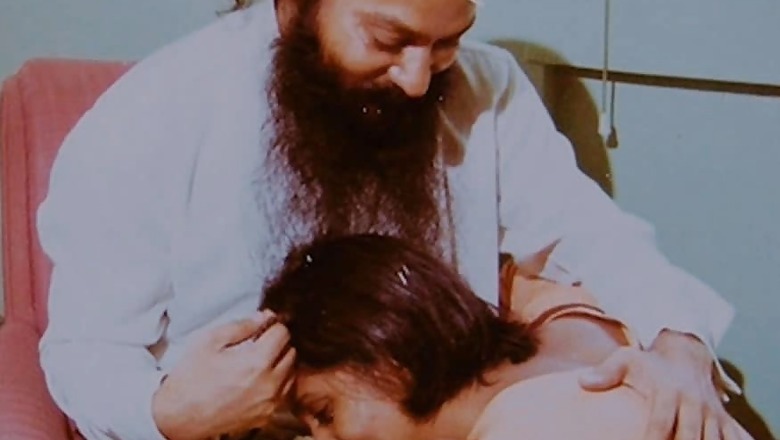
views
New Delhi: Rajneesh's life is well-documented but not many remember his controversial shift to America to establish Rajneeshpuram, a utopian city for his followers in rural Oregon, other than perhaps it inspired Bollywood star Vinod Khanna to abandon fame for orange robes.
The American chapter, between 1981 to 1985, is now the subject of a six-part Netflix documentary "Wild Wild Country" by Maclain and Chapman Way, who went through 300 hours of archival footage to tell a fascinating story of the Rolls-Royce loving Indian mystic who attracted devotion and suspicion in equal measures.
Viewed as a controversial guru, Rajneesh hailed from Madhya Pradesh and after growing into a good public speaker, he moved to Mumbai in 1970. He initiated followers and expanded his spiritual teachings and four years later, he relocated to Pune. After his ashram in the city was met with strong critique and threats of punitive action, Rajneesh considered to establish a new commune in the US.
The cult was eventually driven out of the US. The city, build on a 64,000-acre ranch, largely spurred distrust among the local community and Rajneeshees' attempt to protect it led to bizarre situations.
The followers were accused of immigration fraud, wiretapping, attempts to rig the local election and bioterrorism where they are said to have contaminated the food at local restaurants with Salmonella, making over 700 people sick.
The Way brothers had previously worked on a baseball documentary "The Battered Bastards of Baseball" but when they stumbled upon the never-seen-before archival footage, they realised that they had an interesting story in their hands.
"In 2004, we were given access to 300 hours of archival footage and the archivists told us that the story of Rajneeshpuram was the most 'bizarre story' in the history of Oregon. We started researching and we came across this really complex story about religious rights, immigration issues and different cults in religion," Maclain told PTI in a telephonic interview.
The brothers thought that the story, which they shot with four people in a room, would come and go on Netflix but it has become something of a pop culture sensation.
"The story of Rajneeshpuram has been completely forgotten in America. Even though people internationally had a good grasp of who Osho was, they did not quite know about the American chapter in his life," Chapman said.
The directors believe the documentary shows a period in America where people from different counter-culture movements found an identity in Rajneesh's movement.
"Bhagwan was perhaps the first guru, who married the eastern concept of mysticism with western capitalism to create this very attractive message for a lot of people. It was about self love, self awareness and learning about humanity. It really attracted a lot of highly successful, intelligent people from the East and the West," Maclain said.
"He was able to tap into a very specific period in America where a lot of people were disillusioned with the government and what was happening in the country. It was just after the Vietnam War," he added.
"Wild Wild Country" has been universally praised for its retelling of an almost forgotten but an interesting period in America in a thriller-like format. But some critics believe Rajneesh is more of a shadow than the central figure of the documentary.
"It is not an Osho documentary. He is such a fascinating and complex figure that he deserves his own documentary. Our story takes place at a time when he had taken a vow of silence for four-and-half years, from 1981 to 1985. There was no footage of him teaching or giving a discourse," Chapman said.
Interestingly, when the directors talked to the people who joined the cult, they were never able to "intellectualise" what attracted them to the Rajneesh's teachings.
"It was the strength of longing, the connection of community that they were looking for. So, we were more interested in exploring that," he added.
Another major success for the Way brothers was to connect with important faces of the movement, such as Ma Anand Sheela, who emerges as the central figure in the documentary.
"As we started to digitise the footage, the first character to jump out was Ma Anand Sheela. When Bhagwan took a vow of silence, it created a power vacuum and Sheela kind of started to fill that. I don't know how you tell this story without getting her perspective. The local government had called her 'pure evil'.
"There was naturally a hesitation but she was very hospitable and charming. She gave us a complex interview. She felt she had a story to tell. Sometimes she was reliable, sometimes not," Maclain said.
The directors feel that they have been able to tell a fascinating story of these followers and how they have come to look at this chapter, perhaps the most important one, in their lives.
"We talked to a lot of people from Rajneeshpuram. Some of them still identify themselves with the movement and then there are those who don't consider themselves as 'Sanyasis' anymore and believe they were the part of a destructive cult.
"The biggest takeaway was that followers were thoughtful, intelligent people. They were consenting adults who were looking to do something good in the world. They wanted to transform the society, wanted to build their own Utopia. It was fascinating to see how something that started with such ideas, went down such a destructive path," he said.




















Comments
0 comment